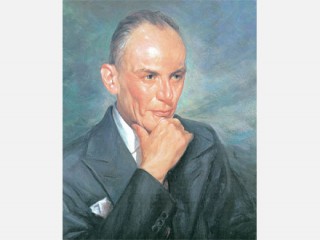
Alberto Lleras Camargo biography
Date of birth : 1906-07-03
Date of death : 1990-01-04
Birthplace : Bogota, Colombia
Nationality : Colombian
Category : Politics
Last modified : 2010-11-15
Credited as : Politician, former President of Colombia, director-general of Pan America union
Twice president of Colombia, director-general of the Pan American Union, and secretary-general of the Organization of American States (OAS), Alberto Lleras Camargo was a journalist and a statesman. He spent most of his life in search of peaceful solutions to the problems of Latin America and his native land.
Alberto Lleras Camargo was born to a prominent family in Bogota, Colombia, on July 3, 1906. When Lleras was 11, his father died, leaving the family penniless. With an older brother's help, he was able to complete high school at a military academy. Lleras entered the School of Law and Political Science of the National Unviversity in Bogota, but left before receiving a degree.
After some newspaper reporting work in Buenos Aires, Argentina, Lleras returned home in 1930 to become editor of Bogota's leading liberal newspaper, El Tiempo. His wit and terse writing style soon made him one of the country's most popular journalists.
By now, Lleras had developed an interest in politics. In 1931 he was elected to the Chamber of Deputies and became its speaker in 1931 and 1933. When his longtime associate, Dr. Alfonso Lopez, became president of Colombia in 1934, Lleras was appointed as his general secretary. The following year, he was named Minister of the Government, the youngest man, at age 29, in the country's history to hold such a post.
Lleras stayed in government until 1938 and then founded El Liberal, Bogota's second largest newspaper. After another stint in the Chamber of Deputies, he was elected to the Senate in 1943 and was appointed ambassador to the United States.
Lleras's U.S. duty was short-lived. He was recalled after only a few months to serve once again as Minister of the Government. In 1945 he led the Colombian delegation to San Francisco for the signing of the United Nations Charter.
Quite unexpectedly, in July 1945, President Lopez resigned, as did his two vice presidents. Lleras was chosen to fill out the term, becoming at age 39 one of the world's youngest heads of state.
When his term expired, Lleras returned to journalism and founded Semana, a news magazine. In 1947 he became director-general of the Pan American Union, the first South American in that position. The following year the union was reorganized as the Organization of American States (OAS), and Lleras was named its secretary-general.
Returning to Colombia, Lleras became president of the University of the Andes in 1954 and then resumed newspaper work. A military dictatorship had now taken over the country. Lleras became the head of the Liberal party, and in July 1956 he met the exiled Conservative Laureano Gomez in Spain to negotiate the Pact of Benidorm, which called for collaboration against dictatorship and committed both parties to an extended period of bipartisan cooperation.
On July 20, 1957, following the collapse of the dictatorship, Gomez and Lleras signed the Declaration of Sitges, creating a revised constitutional system to rule Colombia from 1958 to 1974. Among its major provisions was an equal sharing of congressional, administrative, and diplomatic positions and alternative four-year presidencies between Conservatives and Liberals for the next 16 years.
As a major architect of the National Front, which emerged from these agreements, Lleras was inaugurated as president of Colombia on Aug. 7, 1958. He guided the country toward economic recovery from the fiscal excesses of the dictatorship period. Setting a moderate course in socioeconomic policies, Lleras introduced an austerity program, drastically reduced imports, engaged in public works, and brought national planning to all areas of government. Emphasizing friendly ties with the United States, he was able to bring U.S. technical assistance to the country.
Out of office in 1962 because he could not constitutionally succeed himself, Lleras returned to journalism once more. He became chairman of the news magazine Vision.
In 1931 Lleras had married Berta Puga, daughter of a former president of Chile. The couple had three daughters and a son. Holder of many honorary degrees from universities in Latin America and the United States, including Harvard and Yale, Lleras was also an honorary colonel in the Colombian army. He lived in Bogota until his death on Jan. 4, 1990.
There are no biographies of Lleras in English. The most detailed description of the National Front's evolution and the 1958 election of Lleras is John D. Martz, Colombia: A Contemporary Political Survey (1962). A more recent survey of Colombian politics, which includes an assessment of Lleras's 1958-1962 administration, is Robert H. Dix, Colombia: The Political Dimensions of Change (1967).
















